Notes: Worlington, once in Lackford Hundred, with a known history dating back to the eleventh century, is a pleasant village situated about one mile west-south-west of Mildenhall and on the heathland of what, since 1974, is known as the Forest Heath administrative district of Suffolk. The district embraces the towns of Newmarket, Mildenhall and Brandon with the Forest part of the title alluding to Thetford Forest which spreads across the border from Norfolk into Suffolk. Worlington has a current population of some 375 (Source: Worlington Parish Council. Figures vary greatly according to source) and is situated on the B1102 road and on the south bank of the River Lark. As with Isleham, the river was once the main source of goods transport for the village and incoming goods included hops and barley for the local maltings. This building still stands today. Other industries once included gravel pits, a cooper (barrel maker) and a blacksmith. Like so many other locations, at the time of writing Worlington lacks any form of shop but does have a pub/restaurant and other social and sports activities including a cricket club.
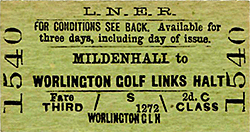 The village is perhaps best known for the Royal Worlington & Newmarket Golf Club, located on the south-east edge of the village. It is a world renowned 9 hole course which can apparently also be played as an 18 hole course by means of alternative tees but it must be stressed that your author is no expert on golf. The course, which is the home course of Cambridge University, was founded in 1893 and permission was granted to include 'Royal' in its title in 1895. The Prince of Wales feathers are thus included in the club's logo. This refers to Prince Albert, of course, Prince Consort and husband of HM Queen Victoria. The club is located on Golf Links Road, which separates the course from the clubhouse. The description ‘links’ for an inland golf course is unusual, the term generally being applied to coastal locations. Golf Links Road joins the Worlington - Red Lodge - Kentford road immediately south of the railway bridge at which was located Worlington Golf Links Halt. Red Lodge, incidentally, is located on the old A11 Newmarket - Norwich road (it is now bypassed) and following WWII and until relatively recent times was the location of a large number of old railway carriage bodies converted into bungalows. Some bungalows consisted of just one carriage body, others consisted of two joined side by side. They were clearly visible from the old A11 and the majority were well maintained with pleasant gardens. It is thought none now exist as Red Lodge today has a large number of modern, permanent, residences. For railway historians Red Lodge was something of a gem and little known outside of East Anglia. The village is perhaps best known for the Royal Worlington & Newmarket Golf Club, located on the south-east edge of the village. It is a world renowned 9 hole course which can apparently also be played as an 18 hole course by means of alternative tees but it must be stressed that your author is no expert on golf. The course, which is the home course of Cambridge University, was founded in 1893 and permission was granted to include 'Royal' in its title in 1895. The Prince of Wales feathers are thus included in the club's logo. This refers to Prince Albert, of course, Prince Consort and husband of HM Queen Victoria. The club is located on Golf Links Road, which separates the course from the clubhouse. The description ‘links’ for an inland golf course is unusual, the term generally being applied to coastal locations. Golf Links Road joins the Worlington - Red Lodge - Kentford road immediately south of the railway bridge at which was located Worlington Golf Links Halt. Red Lodge, incidentally, is located on the old A11 Newmarket - Norwich road (it is now bypassed) and following WWII and until relatively recent times was the location of a large number of old railway carriage bodies converted into bungalows. Some bungalows consisted of just one carriage body, others consisted of two joined side by side. They were clearly visible from the old A11 and the majority were well maintained with pleasant gardens. It is thought none now exist as Red Lodge today has a large number of modern, permanent, residences. For railway historians Red Lodge was something of a gem and little known outside of East Anglia.
The railway eventually arrived at Mildenhall in 1885, passing the south end of Worlington village on the way. Ironically, Worlington village was less than one mile from Mildenhall station via what is now the B1102 and that is a shorter distance than other branch stations were from the villages they were built to serve. During construction the contractor, Lovatt, had his base at Worlington but precisely where is not known. It would not have been near the site of the future halt as that was in a cutting but would have been where the track was at ground level and probably near a road. Most equipment and materials were, however, delivered by rail to Fordham and forwarded initially by road and later by the contractor's own trains. On the Barnwell - Fordham section the contractor set up his base near Swaffham Prior.
The Great Eastern Railway opened Mildenhall Golf Links Halt on 20 November 1922; one of three halts opened on that day in an attempt to attract extra revenue in the face of increasing road competition and, in the case of Mildenhall Golf, to cash in on business to the golf club. This was during a period of economy measures being implemented along the Mildenhall branch, so the GER must be given credit for looking at ways of increasing revenue rather than merely settling for cost-cutting initiatives. However, until DMUs and railbuses appeared on the branch a large number of hauled coaches were converted over a period of time to serve the halts, and in view of the cost of this it is doubtful if the three halts every justified themselves. Details of the rolling stock converted to serve the halts can be found in the Branch History and also in the Cambridge Feature.
It is not known if the golf club originally had Mildenhall in its title but it appears not. The name 'Mildenhall Golf', just those two words, appeared on the destination boards affixed to the side of the 6-wheel conductor-guard stock so it is reasonable to assume that the halt nameboard also included the name 'Mildenhall'. In any event, just a few weeks following opening the LNER renamed the halt to its more familiar name, Worlington Golf Links Halt, on 1 January 1923. This date was the first day of The Grouping and therefore the first day of the LNER's existence. The renaming would thus have been planned by the GER and as these things cannot be done on a whim - they all have to go before various committees and be approved - so the renaming was likely planned immediately after the halt opened. This in turn suggests 'Mildenhall Golf Links Halt' was an error. Such errors were not uncommon and surviving GER records contain several, some of them bearing little resemblance to the correct name and thus difficult to work out.
The three Mildenhall branch halts, the others being Exning Road and Fen Ditton, all opened on the same day (and closed on the same day, 18 June 1962) and were identical in respect of general layout. All were on the up side of the line and on the Cambridge side of their adjacent road bridges. All three were provided with an access pathway cut obliquely into the road bridge approach embankment, a low cinder platform 30ft long and faced with old sleepers (the latter at Fen Ditton, at least, appeared subsequent to opening), a nameboard and an oil lamp. It was the job of train guards to attend the oil lamps at the halts and it has been said that Tilley lamps later replaced the original lamps. However, anybody who knows how to start a Tilley lamp (see Fen Ditton Halt page) will understand how impractical the use of these lamps at unmanned halts would be.
Worlington Golf Links Halt, 19m 68ch from Cambridge and within sight of Mildenhall station, was the most used of the three halts. This is not surprising given its convenient siting for both the village and the golf course. Even so, readers should not conjure up visions of crowds of passengers stumbling down the embankment to the halt. Often there would not be a single passenger for several days and when diesel multiple units and railbuses appeared it became the practice simply not to bother stopping at the halts. With DMUs and railbuses, communication between driver and guard was possible via a number of means. If no passengers wished to alight the guard would inform the driver accordingly. The driver would then slow the train, have a good look and if no intending passengers were waiting, or hurrying along the road waving, the train would not bother stopping. What about lighting the oil lamps? Well, the level of service, especially in later years, meant that the lamps were needed only during the shorter daylight hours of winter. Indeed, many photographs of the halts show no lamp to be present at all.
As can be determined from pictures of all three Mildenhall branch halts, one had to be reasonably agile to use them. The pathways down the embankments were steep and very probably slippery in wet, frosty or icy conditions while the steps, retractable or portable, had to be clambered up or down whilst holding the grab rails on the side of the carriages. The halts were certainly not friendly towards the elderly, people loaded up with shopping, people with perambulators and the physically disabled who would have found the halts virtually impossible to use. But then, as in so many aspects of life, it was a different world over half a century ago. There was no obsession with Health & Safety, no disability discrimination laws, no 'compensation culture': people just got on with life as best they could and seldom made any great fuss.
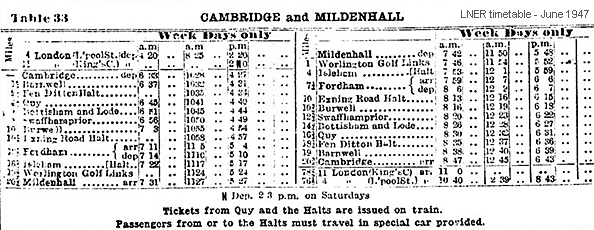
After final closure of the Fordham - Mildenhall section in 1964 bridge 2257, that at Worlington Golf Links Halt, was partially demolished and the gap infilled. The railway was in a cutting at this point so the work was not as drastic as at other locations along the branch. As a result, Worlington Golf Links is the only one of three halts of which some remains can still be seen as of May 2015 - providing one is kitted out for a jungle expedition and knows precisely where to look.
An amusing little anecdote exists concerning Worlington Golf Links and the railway. It is said that golfers who had boarded a train at Mildenhall would drop their clubs out of the window as the train was passing the course and was slowing for the halt. Golfers would alight at the halt then walk back along the track to pick up their clubs before hopping over the fence onto the golf course. The idea was apparently to avoid the need to carry the clubs from the halt to the golf course. For a number of reasons this story seems extremely unlikely so is probably a myth created by a few merry chaps at the nineteenth hole.
Anybody wishing to make the journey by rail today and perhaps play a round or two of golf should purchase a ticket to Kennett.......and be prepared for a four mile walk.
In addition to the images below, an image of Worlington Golf LInks Halt on the final day of passenger services can be seen on the Last Train to Mildenhall page.
BRIEF HISTORY OF THE MILDENHALL BRANCH
The Mildenhall branch arrived relatively late on the railway scene and it could be said that its existence was owed in part to the ill-fated Newmarket & Chesterford Railway (N&C). In 1847 the N&C, with its main line yet to be opened, sought powers to extend beyond Newmarket to Thetford, linking up with the Norfolk Railway, and to Ely and Bury St Edmunds. Of those, the Thetford link was never built; had it been built it would have served the Mildenhall area.
This problem was frustrating Charles Allix (1842-1921) of Swaffham Prior House who approached the GER in 1867 with a view to the construction of a railway from the Swaffham Prior area into Cambridge. The GER rejected the proposal. The next proposal for a railway serving the Mildenhall area was for the ‘Ely & Bury Saint Edmunds Light Railway’, the company's deputy chairman being none other than Mr Allix. This railway was incorporated by an Act of 1875 and a reasonable amount of information has survived about it. Had it been built it would have served the Fordham and Mildenhall areas, but nothing came of the scheme and it was formally abandoned in 1880.
Meanwhile back at Swaffham Prior, Mr Allix remained determined to see his region provided with a railway to help revive local agriculture which was experiencing economic hardship. It is said that every cloud has a silver lining, as Allix was soon to discover. The railway north of Cambridge and onwards to Brandon had suffered problems with flooding, and during 1878 serious disruption occurred once again. This time the GER 'brass' realized that Allix's proposal could, if built, help alleviate the problems, and thus the Mildenhall branch was finally born.
While plans to build the Mildenhall branch were stampeding ahead, the GER had meanwhile re-engineered the vulnerable sections of the Ely - Thetford line. The GER therefore viewed an alternative route, i.e. via Mildenhall, as no longer warranted and this was the reason that the branch never progressed beyond Mildenhall.
Back in the boardroom, the GER was inviting tenders for construction of the Mildenhall branch. With Royal Assent having been received on 18 July 1881, the relevant Act provided for three sections of railway: Barnwell - Swaffham Prior; Swaffham Prior - Fordham; Fordham - Mildenhall. Henry Lovatt, of Wolverhampton, won the contract for the entire route with his tender of £76,327 11s 8d. During October 1882 the contractor moved in to peg-out the course of the line, and on a cold and miserable Wednesday 3 January 1883 some GER grandees and Mr Allix assembled at – unsurprisingly - Swaffham Prior for the usual 'cutting of the first sod' ceremony. During 1883 the signalling contract was awarded to Messrs McKenzie & Holland with signal boxes costing £75 10s each, while local tradesmen were recruited for the erection of station buildings. The station building at Swaffham Prior was built in a somewhat different style from the others in order to mirror the design of Swaffham Prior House.
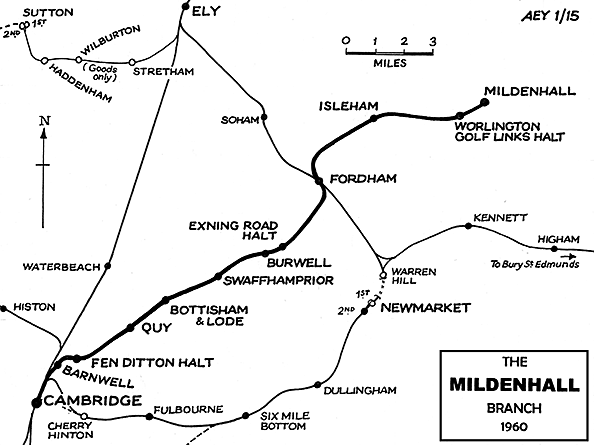
The 19m 3ch route between Barnwell Junction and Mildenhall had no fewer than 70 level crossings. To put this into a less dramatic perspective, only seven were on public roads with the remainder being foot or occupation crossings.
Major General Hutchinson inspected the Barnwell - Fordham section on behalf of the Board of Trade on 28 May 1884. Whilst the inspector found the general standard of construction to be high, a number of issues with fencing and signalling were noted. Permission was given for the line to open if these issues were dealt with quickly - which they apparently were. The inspector also required all trains to call at all stations. Inspection of the Fordham - Mildenhall section, on 28 March 1885, went well, with only a couple of issues at Fordham station. Otherwise, the inspector was impressed with the general standard of construction and gave his consent for the immediate opening of this section.
Passenger services on the branch were never frequent although in the early years they were more or less on a par with other rural branch lines. Despite the possibilities offered by the connection at Fordham with the Ely line, the original timetable offered only four Cambridge - Fordham (and return) services stopping at all stations conforming to the Board of Trade inspector's requirements. Later that year, 1884, this was increased to five return journeys, Thursdays excepted. On that day, Ely market day, advantage was taken of the connection at Fordham and one train continued to Ely, the 12.30pm ex-Cambridge, which returned from Ely at 3.30pm.
With the opening of the Fordham - Mildenhall section the following year, five return journeys travelled the full length of the line although on Thursdays one did not operate between Cambridge and Fordham, and vice versa. Tuesdays and Thursdays saw an additional Mildenhall - Fordham (and return) service but at different times on each of those days. Timetables do not indicate that these trains continued to/from Ely so they were probably connecting services. By 1890 there were additional Thursdays-only/excepted services plus one mixed train. Things then trundled on in much the same fashion until the first decade of the twentieth century.
Despite increases in traffic, especially following the opening of the Fordham - Mildenhall section, the GER was perpetually worried about poor traffic receipts for the line. In 1914 the GER's James Holden decided to experiment with Push - Pull trains as a cost-cutting measure. He borrowed drawings from the London, Brighton & South Coast railway of their Westinghouse (compressed air) Push - Pull control system and converted Y65 2-4-2T No. 1311 and two clerestory bogie coaches into a Push - Pull train with further conversions following later. This train operated trials in service on the Mildenhall branch from 5 October 1914 but the experiment was not considered a success.
The First World War brought considerable extra goods traffic to the line as a result of the government urging farmers to produce more food, but otherwise the war had little effect.
By 1922 the timetable showed just three trains per day operating via Burwell, with the first down train not departing from Cambridge until 10.30am. There was, however, an earlier service to Mildenhall via Newmarket which left Cambridge at 6.47am.
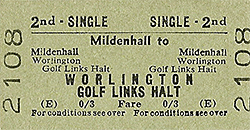 In an attempt to encourage more business, on 20 November 1922 the GER opened three halts on the line at Fen Ditton, Exning Road and Mildenhall Golf Links. They were on the up side of the line, i.e. on the left side of Cambridge-bound trains, and on the Cambridge side of adjacent road overbridges (Bridges 2236, 2242 and 2257 respectively). They were rudimentary affairs: a footpath led down the embankment from the road to end at a low cinder 'platform' faced with what appears to have been old sleepers. In an attempt to encourage more business, on 20 November 1922 the GER opened three halts on the line at Fen Ditton, Exning Road and Mildenhall Golf Links. They were on the up side of the line, i.e. on the left side of Cambridge-bound trains, and on the Cambridge side of adjacent road overbridges (Bridges 2236, 2242 and 2257 respectively). They were rudimentary affairs: a footpath led down the embankment from the road to end at a low cinder 'platform' faced with what appears to have been old sleepers.
The Railways Act of 1921 saw the GER become part of the London & North Eastern Railway (LNER) on 1 January 1923. On this date Mildenhall Golf Links Halt was renamed Worlington Golf Links Halt. The ‘Halt’ suffix appeared in timetables and on tickets but not on the halt nameboards. As the halts had no proper platforms, the GER introduced carriages fitted with retractable steps. Initial conversions were of increasingly antiquated 6-wheeled stock. Because the halts lacked booking facilities the GER introduced ‘conductor-guard’ working, and for this purpose the carriage stock had to be modified to allow the guard to move through the train. Tickets from Quy were also issued on the train.
The LNER viewed the former GER system it had inherited as something of a millstone around its neck and considered the withdrawal of a number of branch passenger services in the east of England. At around the same time the LNER made further economies by reducing the status of Quy and Swaffham Prior signal boxes to shunting frames. In 1935 these two boxes were abolished altogether and at the same time the goods loops through these stations were lifted.
World War Two broke out in September 1939 and this brought some increase in traffic to the Mildenhall branch. As with the First World War, the line saw an increase in agricultural traffic and, as indicated above, of military personnel using the line. Goods traffic vital to the war effort was generally routed from Cambridge via Newmarket during the night. Nevertheless, the need for the railways to focus assets where they were most needed meant that services on the Mildenhall branch remained infrequent. For the duration of hostilities there were still three trains per day each way with the first down train operating via Newmarket. Two goods trains per weekday were provided, one of which commenced from sidings at Coldham Lane Junction, Cambridge.
After the war things returned to pretty much the way they had been previously. On 1 January 1948 the Mildenhall branch became part of the Eastern Region of British Railways. Bradshaw for that date shows three trains each way: down trains at 6.33am, 10.28am, and 4.27pm; and at 7.42am,11.50am and 5.48pm in the up direction. The 6.33am ex-Cambridge omitted the halts, but did call at Quy, and all trains ran via Burwell. By the 1950s there were four passenger trains per day, the final departure being at 9.00pm from Mildenhall, omitting Worlington and operating via Newmarket to Cambridge. The BR 1954 timetable tells us the service had reverted to that of January 1948, as outlined earlier, apart from slight re-timings.
From November 1955 diesels made their first appearance when two brand new sets of Metropolitan-Cammell 79xxx DMUs were sent to Cambridge for timing trials: E79047+E79263 and E79051+E79278. These trials included the Mildenhall branch, commencing on 20 November. By this time more Mildenhall services ran via Newmarket, plus the occasional service from Ely to Mildenhall which involved a reversal at Fordham. From 7 July 1958 diesel railbuses were introduced on Mildenhall branch services. These vehicles lacked retractable steps, as did the DMUs. For the halts, therefore, sets of portable wooden steps were provided and were usually left at the lineside to await their next call of duty.

Goods traffic prior to 1962 was much as previously, with one train per day. By this time, goods trains were usually hauled by Brush Type 2 (Class 31) locomotives with J17 steam locomotives still putting in occasional appearances.
The Mildenhall branch closed to passengers on and from Monday 18 June 1962, with the final trains running on Saturday 16th, there being no Sunday service. On the final day the first down train and its return up working to/from Mildenhall was operated by a 4-car Cravens DMU. A 2-car Wickham unit sufficed for the remainder of the day. The Wickham unit, E50416/E56171, operated the 4.21pm ex-Cambridge and this was the last passenger train along the Barnwell - Fordham section. This train then departed from Mildenhall at 5.15pm to Cambridge via Newmarket. The same DMU then operated the 5.56pm to Mildenhall via Newmarket and the corresponding 7.31pm Mildenhall - Cambridge via Newmarket; this was the final passenger train to and from Mildenhall.
The Burwell & District Motor Service, having suspended its Mildenhall - Cambridge Service 11 at the outbreak of war, had reinstated the service at the cessation of hostilities but truncated it to operate only between Cambridge and Isleham, and it ran only on Saturdays and Sundays. Following withdrawal of the Mildenhall branch passenger trains, B&D modified Service 11 to operate daily and thus it became the rail replacement bus service.
Following the end of passenger services, Isleham and Mildenhall signal boxes closed with immediate effect. The once-daily goods train continued to run, but in the up direction only between Fordham and Cambridge; the down goods ran from Cambridge to Mildenhall via Newmarket. The train was withdrawn on 13 July 1964, the final run being on Friday 10th. This left the Fordham - Burwell section which continued to enjoy a goods service until it was withdrawn on 6 April 1965. Fordham station and its neighbour, Soham, closed on 13 September 1965, and Fordham signal box closed on 28 October 1973.
Tickets from Michael Stewart and David Pearson. Route map drawn by Alan Young. Bradshaw from Alan Young.
Click here to see a 17 minute colour film of a steam locomotive travelling from Cambridge to Mildenhall in 1959. Includes all the stations on the line, From Cambridge Community Archive Network.
Click here for a fuller history of the Mildenhall branch
Click here for special feture: Last Train to Mildenhall
Sources:
- Quick, Michael Railway passenger stations in Great Britain: a chronology (RCTS 2009)
- The Great Eastern Railway (Cecil.J.Allen, Ian Allen 1955)
- The Mildenhall Branch (Peter Paye, Wild Swan 1988)
- Burwell & District Motor Service (Written and published privately by Jim Neale c.1979)
- The London Gazette, November 28th 1879 (Abandonment of Ely & Bury Saint Edmunds Light Railway)
- The National Archive (Information on the Ely & Bury Saint Edmunds Light Railway)
- http://landedfamilies.blogspot.co.uk/ (Information on the Allix family)
See other stations on the Mildenhall branch:
Barnwell Junction, Fen Ditton Halt, Quy, Bottisham & Lode, Swaffham Prior, Burwell, Exning Road Halt, Fordham, Isleham & Mildenhall
See also Cambridge
|

old1.jpg)

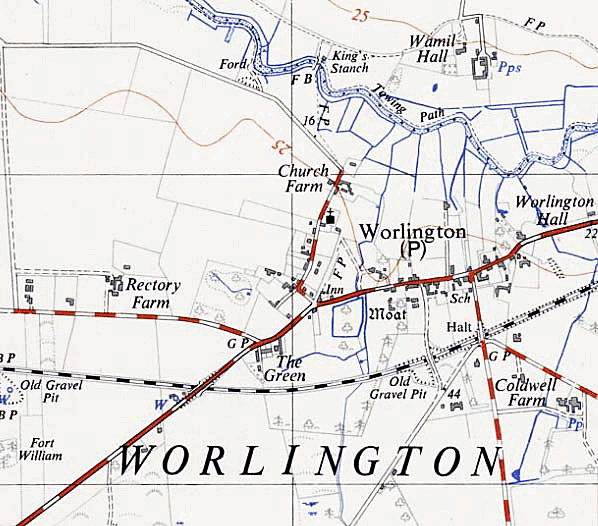
old3.jpg)
old3a.jpg)
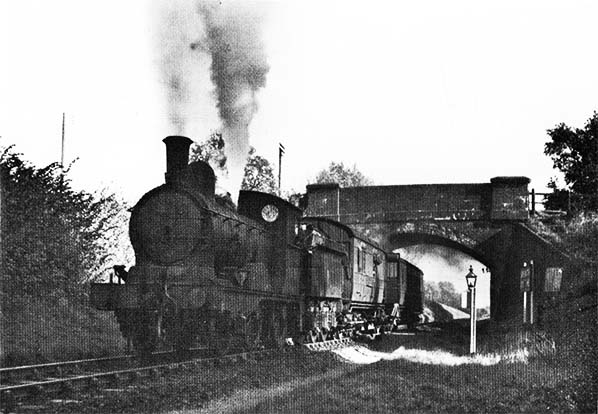
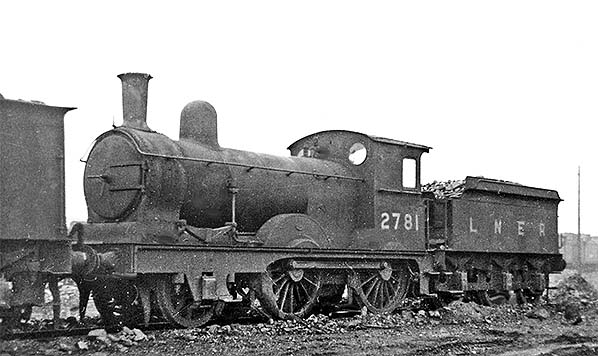
old5.jpg)
old6.jpg)
 The village is perhaps best known for the Royal Worlington & Newmarket Golf Club, located on the south-east edge of the village. It is a world renowned 9 hole course which can apparently also be played as an 18 hole course by means of alternative tees but it must be stressed that your author is no expert on golf. The course, which is the home course of Cambridge University, was founded in 1893 and permission was granted to include 'Royal' in its title in 1895. The Prince of Wales feathers are thus included in the club's logo. This refers to Prince Albert, of course, Prince Consort and husband of HM Queen Victoria. The club is located on Golf Links Road, which separates the course from the clubhouse. The description ‘links’ for an inland golf course is unusual, the term generally being applied to coastal locations. Golf Links Road joins the Worlington - Red Lodge - Kentford road immediately south of the railway bridge at which was located Worlington Golf Links Halt. Red Lodge, incidentally, is located on the old A11 Newmarket - Norwich road (it is now bypassed) and following WWII and until relatively recent times was the location of a large number of old railway carriage bodies converted into bungalows. Some bungalows consisted of just one carriage body, others consisted of two joined side by side. They were clearly visible from the old A11 and the majority were well maintained with pleasant gardens. It is thought none now exist as Red Lodge today has a large number of modern, permanent, residences. For railway historians Red Lodge was something of a gem and little known outside of East Anglia.
The village is perhaps best known for the Royal Worlington & Newmarket Golf Club, located on the south-east edge of the village. It is a world renowned 9 hole course which can apparently also be played as an 18 hole course by means of alternative tees but it must be stressed that your author is no expert on golf. The course, which is the home course of Cambridge University, was founded in 1893 and permission was granted to include 'Royal' in its title in 1895. The Prince of Wales feathers are thus included in the club's logo. This refers to Prince Albert, of course, Prince Consort and husband of HM Queen Victoria. The club is located on Golf Links Road, which separates the course from the clubhouse. The description ‘links’ for an inland golf course is unusual, the term generally being applied to coastal locations. Golf Links Road joins the Worlington - Red Lodge - Kentford road immediately south of the railway bridge at which was located Worlington Golf Links Halt. Red Lodge, incidentally, is located on the old A11 Newmarket - Norwich road (it is now bypassed) and following WWII and until relatively recent times was the location of a large number of old railway carriage bodies converted into bungalows. Some bungalows consisted of just one carriage body, others consisted of two joined side by side. They were clearly visible from the old A11 and the majority were well maintained with pleasant gardens. It is thought none now exist as Red Lodge today has a large number of modern, permanent, residences. For railway historians Red Lodge was something of a gem and little known outside of East Anglia.

 In an attempt to encourage more business, on 20 November 1922 the GER opened three halts on the line at Fen Ditton, Exning Road and Mildenhall Golf Links. They were on the up side of the line, i.e. on the left side of Cambridge-bound trains, and on the Cambridge side of adjacent road overbridges (Bridges 2236, 2242 and 2257 respectively). They were rudimentary affairs: a footpath led down the embankment from the road to end at a low cinder 'platform' faced with what appears to have been old sleepers.
In an attempt to encourage more business, on 20 November 1922 the GER opened three halts on the line at Fen Ditton, Exning Road and Mildenhall Golf Links. They were on the up side of the line, i.e. on the left side of Cambridge-bound trains, and on the Cambridge side of adjacent road overbridges (Bridges 2236, 2242 and 2257 respectively). They were rudimentary affairs: a footpath led down the embankment from the road to end at a low cinder 'platform' faced with what appears to have been old sleepers. 
 Home Page
Home Page